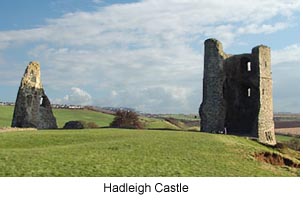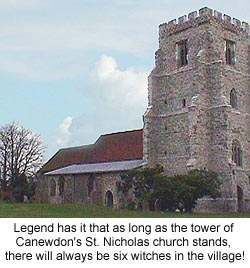The Cunning Men of Essex
by Sue Kendrick
If you think witch doctors lived only in remote regions of darkest African, then you obviously haven't visited the county of Essex and heard the tales of "Cunning Murrell."
 Dubbed the last witch doctor in England, James Murrell was born in 1812 in the village of Hadleigh, just inland from the coastal town of Southend-on-Sea. He was the seventh son of a seventh son, which is said to confer the gift of second sight. A secretive man who travelled only by night, he was a skilled astrologer and herbalist and was often seen collecting plants by the light of the moon and suspending them from the rim of his umbrella. Dubbed the last witch doctor in England, James Murrell was born in 1812 in the village of Hadleigh, just inland from the coastal town of Southend-on-Sea. He was the seventh son of a seventh son, which is said to confer the gift of second sight. A secretive man who travelled only by night, he was a skilled astrologer and herbalist and was often seen collecting plants by the light of the moon and suspending them from the rim of his umbrella.
It was his astrological knowledge that elevated Murrell to the status of a true "cunning man", rather than the more usual hedge witch, wizard or conjuror. Frequently of good education, cunning men (or woman) were thought to practise a form of high magic and ritual largely unknown amongst their more lowly peers. Their knowledge of traditional herbal-based medicine was generally extensive and in some cases ran parallel to orthodox medicine. Whether James Murrell had any formal medical training is unknown, but his skill as a herbalist was legendary.
Like most of his kind, his skills were not confined to humans, but were also dispensed to the animal kingdom. In fact, most cunning men were called upon to treat sick animals as often as their human counter parts. After all, in an age where the death of a pig could spell starvation or at the least a very lean winter, the life of a one child too many often carried less weight than that of the family's main food supply.
Murrell's talents, however, extended far beyond those of simple herbal cures. He had a mirror that had the useful attribute of being able to locate lost or stolen property, while his magic telescope allowed him to see through walls -- which came in very useful should an enquirer suspect his wife of unfaithfulness. The copper bracelet he wore on his wrist had perhaps the most useful function of all: the power to detect dishonest men. No doubt it contributed much to Cunning Murrell's material success.
These were by no means the extent of James Murrell's talents. He often referred to himself as the Devil's Master and claimed to be an adept at exorcising spirits, lifting curses and chastising witches. His witch bottles were well known and were used in conjunction with nail parings, blood, urine and hair. His success at dealing with witches who worked on the dark side was legendary.
One case involved a young girl who barked like a dog and was said to be cursed by a gypsy woman. Murrell made up a witch bottle, which was heated at midnight until it exploded. The next morning, it is claimed, the girl was cured and the charred body of the gypsy was found face down in her campfire.
True to form, James Murrell foretold his death to the day, dying on the 15th of December, 1860. His grave lies unmarked in Hadleigh churchyard.
Besides this unmarked grave, Hadleigh also boasts a castle, although little remains apart from the ruins of two towers and a few low walls. These overlook the Thames estuary and the Essex marshes, both of which are rich in wildlife.
The castle was built in 1230 for Hubert de Burgh, one-time regent for the young King Henry III. It is open year-round. Interestingly, Hadleigh castle was often given to the king's consort for use during her lifetime. Three of Henry the VIII's wives occupied the building -- Catherine of Aragon, Anne of Cleves and Catherine Parr -- none of whom, you can't help but suspect, were in residence long enough to change the wallpaper!
Another famous Essex cunning man, George Pickingill or Pickingale, was a contemporary of James Murrell. Unlike Murrell, he managed to hold fast to this mortal coil for a considerably longer period. Born in 1816, he was 93 when he died in 1909. The tales that surround him are many and various, and like most of those attached to the cunning folk, few can really be substantiated.
 One that crops up in various forms is that Pickingill was the last Master of Witches. His elevated status as a cunning man gave him power over lesser beings. Pickingill himself was said to be both a white and black magician and was viewed with fear and awe by the common folk who, with good reason, trod warily in fear of reprisals should they upset him. He supposedly had a wooden whistle with which he could summon the local witches to do his bidding, and his bewitching skills could put a hex upon farm machinery -- which he would happily lift for the price of a pint! In a more amicable mood, he was said to be a good wart charmer and would act as a negotiator in village disputes. One that crops up in various forms is that Pickingill was the last Master of Witches. His elevated status as a cunning man gave him power over lesser beings. Pickingill himself was said to be both a white and black magician and was viewed with fear and awe by the common folk who, with good reason, trod warily in fear of reprisals should they upset him. He supposedly had a wooden whistle with which he could summon the local witches to do his bidding, and his bewitching skills could put a hex upon farm machinery -- which he would happily lift for the price of a pint! In a more amicable mood, he was said to be a good wart charmer and would act as a negotiator in village disputes.
Tradition states that in the village of Canewdon, where he was born and spent most of his life, there were always six witches, three in silk and three in cotton -- and would be so long as the 75-foot tower of the church of St. Nicholas stands. The dress code suggests that three of the town's witches were of the higher classes, and it was said that at one time, one was the wife of the local clergyman. Other tales say that should a stone fall from this tower, one of the witches will die. It is also said that if you run three times counter-clockwise round the church you will go back in time. When Halloween comes around, the police are often called in to protect the church from enthusiastic time travellers and ghost hunters.
Fortunately Canewdon is no longer subject to the vagaries of Pickingill's moods, but the village regularly receives attention from "ghost hunters" and other psychic investigators. Most Haunted, a popular BBC television programme, based one of its episodes at the church. Most locals, however, seem to think they would have had better luck concentrating their efforts in the car park or the local pub, the Anchor, as most paranormal experiences seem to come from this area.
Staff at the Anchor claim to have seen knives and remote control devices flying through the air, heard the cry of a mysterious baby, and smelt unexplained perfume. The ghost behind all this activity is supposedly that of a young woman called Sarah. Some time during the 1500s she had an affair with a wealthy landowner and became pregnant. When the landowner's wife found out, she insisted that young Sarah be locked away in the building that eventually became the Anchor pub. Once the child was born, she was cruelly murdered. History is silent as to what became of the baby.
Time has moved on since the days of the cunning folk. Modern medicine has replaced mystical herbal cures and simple folk remedies, and the skills and knowledge of the old country folk are known only to a few or lost forever. Or are they?
What's in a name, after all? Today's chiropractors, acupuncturists, herbalists and faith healers may not wander the countryside brandishing umbrellas festooned with herbs, but like the cunning men before them, they have an instinctive understanding of human nature and the skills to manipulate faith and fear -- for good or ill.
Places to Visit:
- Hadleigh Castle & Country Park
- Good place to walk, picnic, fly a kite or discover wildlife. You can explore the park by following one of the self guided trails from Chapel Lane.
- http://www.essexcc.gov.uk
- Essex Police Museum
- Charts the history of Essex Police from its foundation in 1840 to the present day. Extensive collection of uniforms and equipment, along with archives of personnel, police history and criminal activity in Essex. The museum also runs a family history research service for those whose relatives have served with Essex Police. Contains case histories of trials featuring witchcraft.
- http://www.essex.police.uk/museum
- East of England Tourist Board
- http://www.visiteastofengland.com/
More Information:
We regret that we no longer have the resources to maintain up-to-date links and/or hours and pricing details for the various sites and attractions listed on this website. For more information about the location(s) listed above, please use your favorite search engine or visit Wikipedia.
Sue Kendrick is a freelance writer living in the English Midlands. She has written many special interest articles for magazines and newspapers and contributed an uncountable amount of news stories to her regional newspaper. She edits and publishes WriteLink (http://www.writelink.co.uk), a UK writers' resource website and monthly newsletter. She also writes fiction and has won several prizes for her short stories. When not writing, she likes to walk, ride, read and pursue her interest in small scale farming (not necessarily in that order!). For more information, visit http://www.suekendrick.co.uk.
Article and photos © 2005 Sue Kendrick
|
